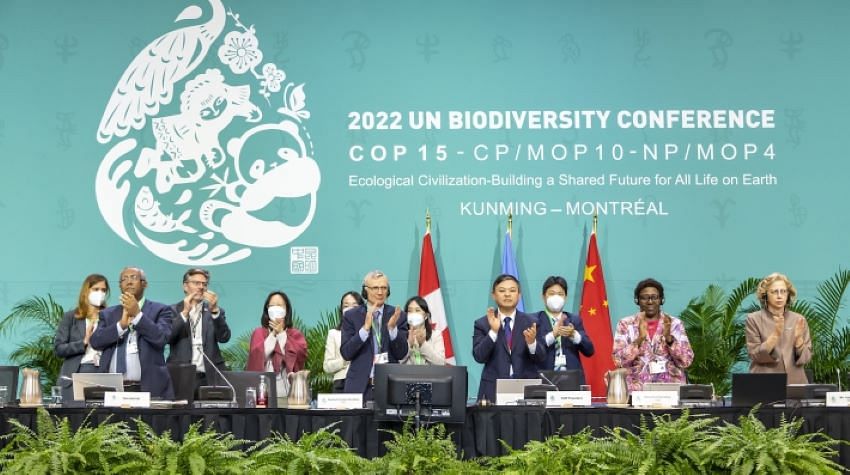
The Kunming-Montreal Global Biodiversity Framework's agreement includes 23 targets to protect nature and was adopted at the UN Convention on Biological Diversity's 15th Conference of Parties, which concluded on December 19.
The goals are to reduce biodiversity-harming subsidies by $500 billion per year, to cut the introduction of alien invasive species by half, and to "bring the loss of areas of high biodiversity importance, including ecosystems of high ecological integrity, close to zero" by 2030.
The agreement also established the overarching goal of effectively conserving and managing at least 30% of terrestrial, inland water, coastal, and marine areas of "special importance for biodiversity" by 2030. The COP15 biodiversity summit was held in Montreal from December 6 to December 19. The agreement's adoption was not without controversy, with at least four African countries expressing concerns about the text, particularly the financial arrangements for the biodiversity agreement.
Stopping biodiversity loss and restoring degraded ecosystems are viewed as critical steps toward mitigating the effects of climate change. The latest edition of the Global Biodiversity Outlook report by the Intergovernmental Science-Policy Platform on Biodiversity and Ecosystem Services (IPBES) pegged the number of species threatened by extinction at 1 million, warning that the current rate of extinction is "at least tens to hundreds of times higher than it has averaged over the past 10 million years."
The Intergovernmental Panel on Climate Change, a United Nations body, has stated that limiting global warming will be impossible without forest conservation. The Global Biodiversity Framework, which is being likened to the 2015 Paris Agreement on climate change, aims to "implement broad-based action to bring about a transformation in our societies' relationship with biodiversity by 2030, in line with the 2030 Agenda for Sustainable Development and its Sustainable Development Goals". "The suggestions from India to keep all the goals and targets, globally, were accepted, along with other propositions," said India's Union environment minister Bhupender Yadav.
The GBF heard India's pitch for LiFE, Lifestyle for Environment, and common but differentiated responsibilities and respective capabilities." India launched the LiFE Mission earlier this year with the goal of promoting healthy lifestyles around the world. One of the agreement's goals is to "encourage and enable people to make sustainable consumption choices," with the goal of reducing the global footprint of consumption and waste generation in an equitable manner by 2030. The agreement aims to reduce the rate of extinction and the risk to species by tenfold by 2050, while "significantly increasing the area of natural ecosystems."
The 14-page Framework document covers goals such as equitable genetic resource sharing, indigenous rights over protected areas, and the need to close the biodiversity conservation funding gap. The framework aims to reduce the loss of areas of high biodiversity importance due to changes in land and sea use to "near zero" by 2030. Another goal is to reduce pollution risks to biodiversity to "non-harmful" levels by 2030, such as reducing pesticide and highly hazardous chemical risks by at least half.
Some of these targets were contested during talks by developing countries, including India, who argued that a "one size fits all" approach is not acceptable. On Sunday, Yadav made an intervention at a stocktaking plenary meeting a day before the talks were set to conclude, saying that for developing nations, "agriculture is a paramount economic driver for rural communities, and the critical support provided to these sectors cannot be redirected".
"When food security is of paramount importance for developing countries, prescribing numerical targets in pesticide reductions is unnecessary," he said at the plenary session. Negotiations over funding for biodiversity were also tense. Days before the talks ended, developing countries, including India, staged a walkout during finance talks, claiming that rich countries were unwilling to commit to a comprehensive package.
Developing countries demanded a new fund dedicated to implementing the framework, but developed countries objected, arguing that funding should continue through existing mechanisms. So far, the only fund for biodiversity is the Global Environment Facility, which also caters to other conventions such as the UN Climate Convention. According to the Kunming-Montreal Global Biodiversity Framework, there is a $700 billion annual biodiversity finance gap, and it aims to mobilise $200 billion in biodiversity financing through existing mechanisms.
It also opens the door to future conventions discussing separate funding arrangements. According to the document, agreement to the framework will be subject to planning and monitoring. Countries are expected to develop and implement national biodiversity strategies and action plans that are consistent with the framework.











